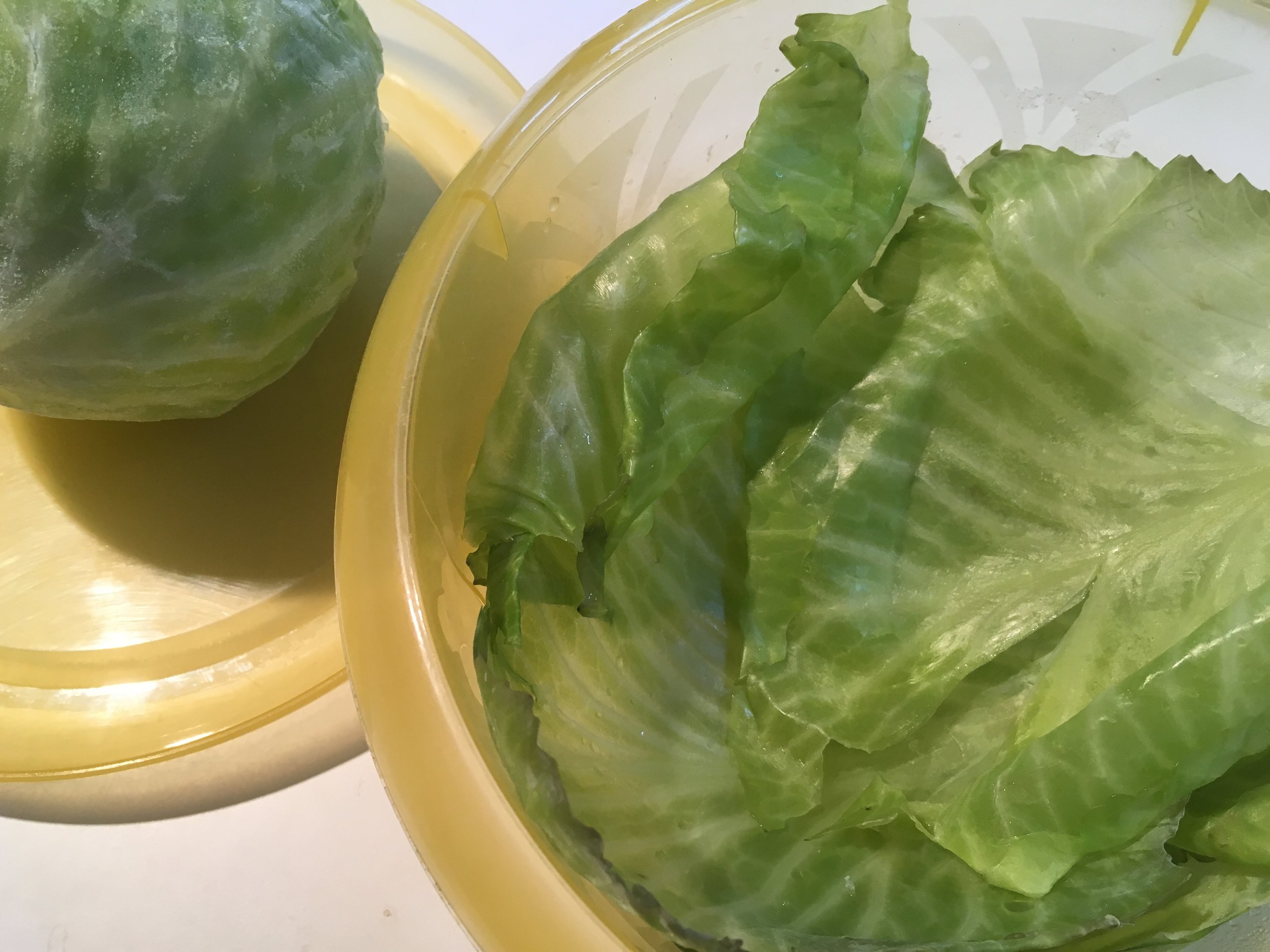Stuffed Cabbage, Hungarian-Style • Jolie Mansky
Bretty Rawson
Note from curator Rozanne Gold: Jolie Mansky’s memories of her grandmother’s stuffed cabbage are mouthwatering. The same can be said of the recipe I enjoyed making so much — knowing I would serve it sometime during this year’s Rosh Hashanah holiday (year 5777), and well into the wintery months. Appropriately seasoned with sweetness (apples, raisins, honey, brown sugar and onions) and quite in contrast to the sauerkraut-y flavors of my own Hungarian mother’s version, its dulcet notes are perfectly in tune. Jolie, an ebullient New Yorker, is the proprietor of Urban Concierge U.S., a company that enables others to “fulfill a desire or a dream — from the perfect meal or sold-out event ticket, to a unique getaway day trip or global vacation.” I would say she should add sharing treasured recipes to that list and I encourage her to turn her family memoir First, You Brown the Onions, into a cookbook for a wider audience. Thanks, too, to Allison Radecki for her editing prowess.
Stuffed Cabbage, Hungarian-style by Jolie Mansky
I have many memories of cabbage — from my Mom’s cabbage soup to the stuffed leaves featured here. But it is this recipe, unbelievably delicious, schmaltzy, tasting both sweet and tart, that brings back incredible memories of childhood: Family gatherings, holidays, the powerful aroma of onions and tomatoes slowly cooking, that first taste of sweet-and-sour flavors, and being at my grandparents’ home joined by many cousins.
All the women in my family (great-grandmother, maternal grandmother, great aunts, mother, and aunts) made this dish for the holidays. It particularly links me to the three generations of women that came before me: my mother, Sherry Stauber Roberts, my grandmother, Lillian Adler Stauber, and Mechlya Popovitz Adler-Weiss, my great grandmother.
Sherry was born at home in Brooklyn; Lillian in 1905 in Viseu de Sus, Romania (or Hungary, depending on who you ask and who was in power); Mechlya was born in Hungary-Romania in 1883.
Mechlya was a midwife and became a professional caterer in the U.S. I don’t know that she loved to do anything. She was just constantly busy doing what she had to do.
Lilly was an amazing balaboosta (the Yiddish term for the perfect housewife and someone who provides sustenance to the family); she cooked, she cleaned, she hosted. Besides having and maintaining a beautiful home, Lilly also loved to play cards.
Sherry, my mother, is also a fantastic balaboosta. At age 90, a retired buyer, she now loves to read, knit, play Lexulous online, watch HGTV (Bobby Flay and Cook or Con) and follow everyone on Facebook. My mother has written this recipe out for me for over thirty years. Not surprisingly, the recipe changes a bit each time.
When I compiled a family memoir called First, You Brown the Onions, I made sure to include a copy of this dish within its pages. I also have several copies of my mother’s handwritten “originals.”
I have always been fascinated how different cultures make similar dishes with what is available. I love stuffed grape leaves. The Iranian version, cooked in a pomegranate reduction, is divine. Then, there is the Levant, where every conceivable vegetable is stuffed, zucchini, peppers, tomatoes, and even onions.
My earliest recollections of my grandparents’ home involve food and ritual. I remember my grandfather, Izzie, getting up at the crack of dawn and faithfully laining his tefillin, putting on the black leather boxes which contain Hebrew parchment scrolls. He would mumble his prayers rapidly and say “shah” if anyone interrupted.
My grandmother, Lilly, was always cooking, even after a stroke rendered her partially paralyzed at age 58. She had to cut the vegetables perfectly even then. Lilly had set menus for every night of the week, which must have made life easier. Everything she made was delicious.
To this day, I can still lovingly detect a Jewish-Romanian accent. When I hear this accent, and see the sparkling gold teeth of immigrants, I close my eyes and remember the love I felt as a child.
STUFFED CABBAGE (Hungarian Style)
SOFTEN CABBAGE LEAVES (can be done in one of two ways):
1. Cut out, core and wash cabbage. Cover in plastic wrap and place in freezer overnight. When thawed, leaves are soft and ready to take off. –OR-
2. Cut out core and place cabbage in large pot of boiling water. Steam until soft enough to remove leaves. You may have to put it in boiling water a few times.
SAUCE: In bottom of large pot:
Shred cabbage (all leaves not used for filling)
2 Onions, chopped
1 large can crushed tomatoes
1 small can tomato paste
1-2 sliced apples
1/2 cup raisins
1/2 cup brown sugar & 3 Tbsp. sugar
Juice of 1 lemon
(Adjust seasoning during cooking)
Salt & pepper
2 Tbsp. honey
2 cups water - watch if more needed
FILLING:
1 1/2 lbs. ground beef
Salt & pepper
Bread crumbs (or Matzo meal)
3 Tbsp. of prepared sauce
1 grated onion
1/2 cup raw rice (rinsed)
COOKING:
- Place cabbage rolls - rolled with 2 ends tucked in (they hold closed) on top of sauce.
- Simmer to a slow boil. Cover and cook about 2 hours.
- During cooking, watch to make sure that the rolls are not sticking to the bottom of the pot. Gently shake pot to keep rolls from sticking.
- I separate the prepared sauce into two parts and pour the last half over the cabbage rolls.
- When cooled, place the cooked rolls in a baking pan, in rows. Dribble a little honey over the cabbage rolls and brown before serving.




